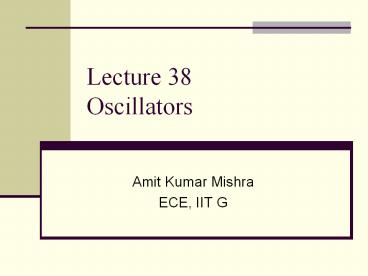Lecture 38 Oscillators - PowerPoint PPT Presentation
1 / 21
Title:
Lecture 38 Oscillators
Description:
Lecture 38 Oscillators Amit Kumar Mishra ECE, IIT G Amplitude Stabilization Loop gain of oscillator changes due to power supply voltage, component value or ... – PowerPoint PPT presentation
Number of Views:648
Avg rating:3.0/5.0
Title: Lecture 38 Oscillators
1
Lecture 38Oscillators
- Amit Kumar Mishra
- ECE, IIT G
2
Amplitude Stabilization
- Loop gain of oscillator changes due to power
supply voltage, component value or temperature
changes. - If loop gain is too small, desired oscillation
decays and if it is too large, waveform is
distorted. - Amplitude stabilization or gain control is used
to automatically control loop gain and place
poles exactly on jw axis. - At power on, loop gain is larger than that
required for oscillation.As oscillation builds
up, gain is reduced to minimum required to
sustain oscillations.
3
Amplitude Stabilization in RC Oscillators Method
1
R1 is replaced by a lamp. Small-signal resistance
of lamp depends on temperature of bulb
filament. If amplitude is large, current is
large, resistance of lamp increases, gain is
reduced. If amplitude is small, lamp cools,
resistance decreases, loop gain increases.
Thermal time constant of bulb averages signal
current and amplitude is stabilized.
4
Active LC oscillator
- Higher range
- Higher Q factor (gt ??)
5
Hartely (b) and Colpitt (a) oscillators
6
LC Oscillators Colpitts Oscillator
D0, collect real and imaginary parts and set
them to zero.
At w0
Generally more gain is used to ensure oscillation
with amplitude stabilization.
7
LC Oscillators Hartley Oscillator
D0, collect real and imaginary parts and set
them to zero.
At w0
G-S and G-D capacitances are neglected, assume no
mutual coupling between inductors.
Generally more gain is used to ensure oscillation
with amplitude stabilization.
8
Another practical Colpitt Osc.
9
Crystal oscillator
- In its heart is a piezoelectric crystal
- Pizo crystal have opposite faces plated with
electrodes. - 3 major advantages
- Very high Q (10s to 100s of thousands)
- Stable with temp. and time
- Can give freq. upto several MHz
- Q and res. Freq. depends on the size,
orientation of faces, and mount
10
Crystal Oscillators
Crystal A piezoelectric device that vibrates is
response to electrical stimulus, can be modeled
electrically by a very high Q (gt100,000) resonant
circuit. L, CS, R represent intrinsic series
resonance path through crystal. CP is package
capacitance. Equivalent impedance has series
resonance where CS resonates with L and parallel
resonance where L resonates with series
combination of CS and CP.
Below wS and above wP, crystal appears
capacitive, between wS and wP it exhibits
inductive reactance. Used to replace L in Colpitt
11
Crystal
12
Crystal Oscillators Example
- Problem Find equivalent circuit elements for
crystal with given parameters. - Given data fS5 MHz, Q20,000 R 50 W, CP 5 pF
Analysis
13
Pierce crystal oscillator configuration
14
Crystal Oscillators Topologies
Colpitts Crystal Oscillator
Crystal Oscillator using BJT
Crystal Oscillator using CMOS inverter as gain
element.
Crystal Oscillator using JFET
15
The classic 555 timer circuit
- Since 1972 (by Signetics Co.) called IC Time
Machine! - Numerous clones available
- Low-cost, accurate and easy to design with (gt1B
units per year) - 23 Transistors 2 diodes 16 resistors (DIP-8)
- Can work in monostable, astable and bistable
configurations
16
From the SE555 datasheet
17
Schemtics
18
Block diagram
- SR0 QQ
- S1R0 Q1
- S0 R1 Q0
- Vcc 5V
- Vth 2/3Vcc
- Vtl 1/3Vcc
- Why 555?
- Transistor switch
19
Monostable configuration
20
Astable configuration
21
Many Thanks






























